
NEW DELHI (Reuters) – When Reserve Bank of India (RBI) governor Urjit Patel abruptly resigned on Monday, it stunned many people in government and business circles.
Patel’s decision, which came after months of bad blood between India’s central bank and the government, is the latest sign that the ruling Bharatiya Janata Party (BJP), led by Prime Minister Narendra Modi, is increasingly demanding that it get its way in the country’s premier institutions.
From the RBI, the government demanded a reduction in lending curbs and a share of its surplus reserves.
Patel was appointed by Modi, but he resisted the demand. With him gone, and his replacement being a loyal ex-government bureaucrat, Modi is now expected to get most of what he wanted.
Other institutions know what it’s like. Those who have been in the Hindu nationalist government’s crosshairs include India’s equivalent of America’s FBI, its statistics authority, the civil service, the state media, and even Modi’s own cabinet.
Sources in all of those areas have told Reuters they face political interference and a drive for centralized decision-making from a government under pressure to deliver results before a general election due by May next year. The BJP’s defeats in some key state elections this week will pile on additional pressure.
The prime minister’s office did not respond to a Reuters request for comment on the subject. The government’s main spokesman declined to comment.
Modi has not held a news conference during his time as prime minister and interviews are few and far between. He prefers to use Twitter to communicate and has a monthly radio broadcast to the nation.
Some political analysts and government officials label him as authoritarian. They say such autocracy is a dangerous game in India given the complex ethnic, religious and caste divisions among its 1.3 billion people.
“You can’t govern like you do in China,” said Mohan Guruswamy, founder of the Centre for Policy Alternatives think-tank and a former finance ministry official.
“You have to constantly build consensus. Even the British consulted people, and the Mughals co-opted local kings into their army,” he said, referring to rulers in India before independence.
Others see the RBI merely as the latest battleground in a broader culture war between right-wing Hindu nationalists allied with the BJP, and a liberal intelligentsia that still dominates India’s legal system, academia and English language media.
“The right feels like these institutions are rigged by the left,” said Harsh Pant, a political scientist at the New Delhi-based Observer Research Foundation.
MODI’S CONTROLLING WAYS
Political interference is nothing new in India, ruled for decades after independence by the Congress party and its Nehru-Gandhi dynasty that still plays a leading role in the party which is now in opposition.
In 1975, then prime minister Indira Gandhi suspended civil liberties for nearly two years in an event known as the Emergency to quell what she said were attempts to destabilize the country from within.
“This is an Indira Gandhi 2.0 government,” Pant said. “Not since she was in power has there been a government this strong.”
Jawhar Sircar, a former chief executive officer of the Prasar Bharati corporation that runs India’s state media, said board positions at more than 70 state enterprises have been lying vacant for 2-3 years because of the backlog of files in Modi’s office.
“Every appointment of officers of the Republic of India is determined by one man,” he said.
Earlier this week, a federal minister from a regional political party quit Modi’s government on the grounds that he was a minister without power and that Modi neglected his party’s concerns.
“The Union Cabinet has been reduced to a rubber stamp, simply endorsing your decisions without any deliberation. Ministers have become figureheads as virtually all decisions are taken by you, your office,” Upendra Kushwaha wrote in a letter to Modi.
Milan Vaishnav, a senior fellow researching India at the Carnegie Endowment for International Peace in Washington D.C., said Modi was looking to run “a centralized government in which the prime minister’s office reigns supreme, the cabinet takes a backseat, and institutional checks and balances are treated as a bug, rather than a feature.”
CBI FIGHT
In October, the government fired the head of the top federal crime fighting agency, the Central Bureau of Investigation (CBI), and his deputy after the two were embroiled in a public fight over allegations of corruption.
In a petition to the Supreme Court, sacked CBI director Alok Verma said the move “erodes the independence of the institution” as well as officers’ morale.
Even before the fight, the agency’s powers were being clipped, CBI officers said. In July, the government made it harder for the CBI to launch investigations against public servants by tweaking a key law, one said.
Some critics say even the government’s economic data has been tainted by politics.
Last month, the BJP faced fire for the release of new historical GDP figures from the Central Statistics Authority that significantly downgraded growth during the years Congress was in power.
Sudipto Mundle, who worked on a previous set of statistics that showed higher growth, said politicizing India’s economic data was “very troubling”.
One institution that is standing firm is India’s Supreme Court, although it too has faced challenges, say justices and lawyers.
The country’s top court has released landmark judgments legalizing gay sex and adultery to the alarm of Hindu traditionalists. It held individual privacy as a fundamental right, pushing back against the government’s efforts to make the use of a biometric ID program for all citizens mandatory.
But Prashant Bhushan, a Supreme Court lawyer at the forefront of a campaign to defend judicial independence, said the government was consistently looking for ways to influence the top court.
“The pressure remains, the government is trying to undermine the court, by sitting on judicial appointments,” said Bhushan.
REUTERS

Leave a Reply
You must be logged in to post a comment.